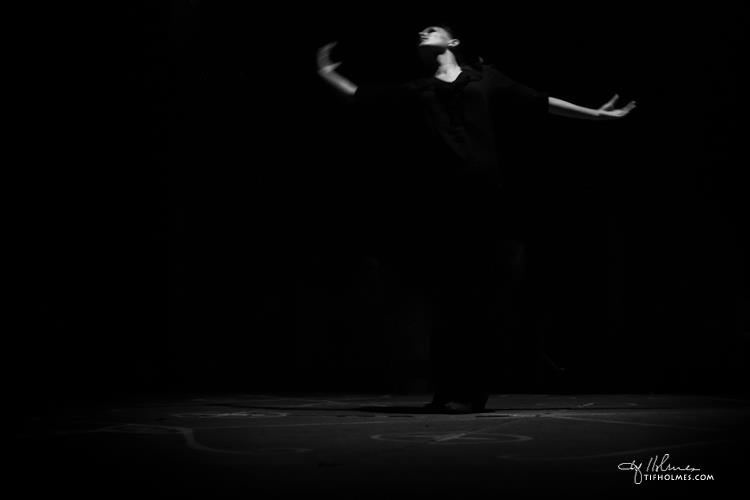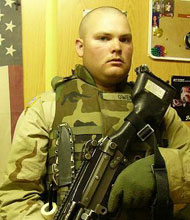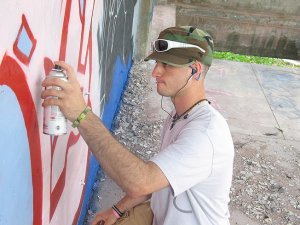Traditional Students and Veterans: Using Drama to Bridge a Difficult Gap
By Gaby Bedetti
“Fantastic show, that’s what education should look like!” said Travis Martin’s generous e-mail in response to our class’s attempt to capture the experience of war and its aftermath in a play. “A wonderful, often moving piece of theatre,” wrote a professor about “From Shiloh to Afghanistan.” Neither suggested a disconnect between war and the students’ representation. Yet Daniel Buckman’s “Swords to Pencils: Thoughts on the Veteran Experience in Academics” articulates a troubling question: Did any of us develop a real understanding of the veterans’ experience?
Comprised of traditional students, our Eastern Kentucky University class spent spring 2015 armchair traveling from the American Civil War to the modern-day battlefields of the Middle East. Neither my co-teacher, Mason Smith, nor I have fought in a war, so, to mark the 150th anniversary of the Civil War, we focused on its bloodiest battle. To convey what they had learned from reading history and fiction, the students wrote, directed, and performed six one-act plays on May 7 in the Black Box Theatre of the EKU Center for the Arts. A jug band from the seminar performed brief interludes of Appalachian songs. The production concluded with “A Litany for Our Veterans,” constructed from lines of poetry about all the wars in which Americans have fought. The litany’s elegiac tone projected an earnestness its fifteen reciters may not have earned.

The students dramatized their generation’s stories in various ways. For example, in “An Ignorant Soldier” a time-traveling student journeyed back to the Battle of Shiloh, where he accidentally killed Gen. U.S. Grant and started a chain of events that altered the course of history. “Row Your Boat” depicted a straggler and a general at the Battle of Shiloh trapped as one struggled to row toward safety, and the other toward battle. Martin coached the writers to tweak the dialogue and behaviors to make them more realistic. He challenged the writer of “Homecoming,” whose brother is in the military, to aim for a more nuanced portrayal of a veteran with PTS in this excerpt:
LITTLE GIRL
(approaches him with a clip board in attempt to sell cookies)
Excuse me sir?
RANDY
(coldly)
Get away from me.
LITTLE GIRL
What, no? I just have a question for you.
RANDY
(panicked)
What are you hiding behind that clipboard?
(rips it out form her hands and she accidently falls back out of shock and cries)
What do you want? Get away!
LIBBY
(Libby hears the shouting and runs over)
Hey, hey, hey! Calm down she’s just selling cookies. What’s going on?
RANDY
She wouldn’t listen. I told her to get away and she wouldn’t. She needs to get away from me.
The writer modified the violence by having only the clipboard fall, not the little girl. A deeper understanding of those who have experienced war calls for a more authentic learning experience.
In order to respond to what Buckman aptly characterizes as the narcissism of the traditional student, academics could collaborate with the veteran community. In her article, “Veterans Studies: Expanding Notions of ‘Vet Friendly’ to Include the Curriculum,” Penny Coleman endorses Martin’s call to bring both veterans and non-veterans together. The course could be cross-listed in EKU’s Veterans Studies Program. Veterans would educate instructors about their needs and learning styles, as Sarah Gann suggests. Voices of Student Veterans and Verbatim Theatre could teach the kinesthetic learning style emphasized in military training and favored by traditional students today. While the class could never approximate the cohesiveness and camaraderie that Buckman describes in his all-veterans composition class, integrating drama may help bridge the gap.
Along with collaborating with veterans, instructors might focus the reading strategically. With so much excellent war literature available, we could pair works from JME with Civil War readings. We could showcase the experience of women involved in war, as Martin advised, by juxtaposing a female hospital nurse’s experience during the Civil War and Erin Byers’ “Dear America.” Another approach to making the course more genuine would be to have the class focus on a particular image the way Lund focuses on images of hands as a writing prompt and shortcut to agency. An alternative is to focus on a specific moment, such as the night before battle, a motif memorialized in Book VIII of Homer’s Iliad, and captured in the EKU student play, “Shootin’ the Breeze.”
Finally, instructors could more overtly use the course to bridge the gap between veteran and traditional students. To promote points of empathy, we could use a public blog to engage soldiers and veterans in virtual interactions. We could bring veterans into the course through JME and veterans on campus. A veteran could serve as a visiting instructor. Students in the course could help promote the field of Veterans Studies by presenting at the Veterans in Society Conference. A course titled “Battle of Shiloh: Drama for the 21st Century” would be enriched by the coming together of veterans with traditional students.
Our hope is that by improving the course design, the military will exist beyond the university enclaves Buckman describes. Rather than carrying what Gann calls the “burden of seclusion,” veterans will help educate traditional students. As brothers, friends, and fiancés of people in the military, many traditional students have a degree of exposure to the moral and literal injuries of war. Gann presents the academy with an opportunity it cannot waste. The million current VA Education beneficiaries provide the academy with what Gann describes as “an occasion in which it can rise to greatness, to serve those who have greatly given in selfless service.” Bringing soldier and student together in the classroom to write and produce plays about the experience of war is a step toward healing and reconciliation.

The trailer for the play is available at https://www.youtube.com/watch?v=RWXetx-jfeo.
A recording of the performance is available at https://www.youtube.com/watch?v=KEPF-DaJOwY.









 Dominic is continuing to work as a practicing artist. Since the Arts and the Military/AMH week he has created murals in Chicago and in Santa Barbara — the first for the National Veterans Art Museum and the second for the University of California at Santa Barbara.
Dominic is continuing to work as a practicing artist. Since the Arts and the Military/AMH week he has created murals in Chicago and in Santa Barbara — the first for the National Veterans Art Museum and the second for the University of California at Santa Barbara.